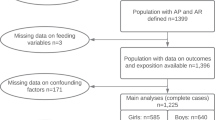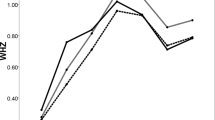Abstract
Objective: To investigate infant feeding patterns during the first 2 y and their relation to sociodemographic factors.
Design: A population-based cohort study.
Setting: Oulu and Tampere University Hospital district areas 1996–1999, Finland.
Subjects and methods: All newborn infants (n=675) with increased genetic risk for type I diabetes were invited to the study in 1996–1997. Of these, 429 (64%) completed the dietary follow-up form by the time they reached 2 y of age.
Results: The median duration of exclusive breastfeeding (BF) was 1.8 months (range 0–6 months) and that of total BF 7.0 months (0.3–25 months). Among the infants 20% were exclusively breastfed at least 4 months (recommendation 4–6 months). Infants were introduced to infant formula at the median age of 1.8 months (range 0–25 months) and other supplementary foods at the median age of 3.5 months (1–6 months). Infant's ponderal index at birth was inversely associated with the duration of total BF. The age of introduction of supplementary foods correlated positively with the duration of total BF. Longer parental education and increased maternal age were associated with a longer duration of BF and older age at introduction of supplementary foods. Infant formula and other supplementary foods were added earlier to the diet of the boys than that of the girls.
Conclusion: Duration of breastfeeding in Finland is shorter than recommended. Compliance with the current recommendations on the timing of introduction of first supplementary food and dairy products is relatively poor. The diet during infancy seems to be conspicuously influenced by the duration of parental education, maternal age and the sex of the infant.
This is a preview of subscription content, access via your institution
Access options
Subscribe to this journal
Receive 12 print issues and online access
$259.00 per year
only $21.58 per issue
Buy this article
- Purchase on Springer Link
- Instant access to full article PDF
Prices may be subject to local taxes which are calculated during checkout

Similar content being viewed by others
References
American Academy of Pediatrics; Work group on breastfeeding (1997): Breast-feeding and the use of human milk. Pediatrics 100, 1035–1039.
Chandra RK (2002): Breastfeeding, hydrolysate formulas and delayed introduction of selected foods in the prevention of food hypersensitivity and allergic disease. Nutr. Res. 22, 125–135.
Daly A, MacDonald A & Booth IW (1998): Diet and disadvantages: observations on infant feeding from an inner city. J. Hum. Nutr. Dietetics 11, 381–389.
Dewey K (2000): Complementary feeding and breastfeeding. Pediatrics 106, 1301.
Dewey KG, Peerson JM, Brown KH, Krebs NF, Michaelsen KF, Persson LA, Salmenper L, Whitehead RG, Yeung DL & the WHO Working Group on Infant Growth (1995): Growth of breast fed infants deviates from current reference data: a pooled analysis of US, Canadian, and European data sets. Pediatrics 96, 495–503.
Erkkola M, Karppinen M, Järvinen A, Knip M & Virtanen SM (1998): Folate, vitamin D, and iron intakes are low among pregnant Finnish women. Eur. J. Clin. Nutr. 52, 742–748.
ESPGAN Committee on Nutrition (1982): Guidelines on infant nutrition. III. Recommendations for infant feeding. Acta Paediatr. Scand. 302 (Suppl), S1–S27.
Fall CHD, Barker DJP, Osmond C, Winter PD, Clark PMS & Hales CN (1992): Relation of infant feeding to adult serum cholesterol concentration and death from ischaemic heart disease. Br. Med. J. 304, 801–805.
Forsyth JS (1995): The relationship between breast-feeding and infant health and development. Proc.Nutr. Soc. 54, 407–418.
Freeman V, van't Hof Martin, Haschke F & the Euro-Growth Study Group (2000): Patterns of milk and food intake in infants from birth to age 36 months: The Euro-Growth Study. J. Pediatr. Gastroenterol. Nutr. 31 (Suppl), S76–S85.
Hasunen K (2002) Infant feeding in Finland 2000. Reports of the Ministry of Social Affairs and Health, ISSN 1236-2115;2001:12. Helsinki: Oy Edita Ab.
Hasunen K, Heinonen K, Lyytikäinen A & Sairanen S (1996): Imeväisikäisten ruokinta Suomessa 1995 (In Finnish) Ministry of Social Affairs and Health, Sosiaali-ja terveysministeriön selvityksiä 1996:2. Helsinki: Oy Edita Ab.
Hasunen K, Kalavainen M, Keinonen H, Lyytikäinen A, Nurttila A & Peltola T (1997): Lapsi, perhe ja ruoka. Imeväis- ja leikki-ikäisten lasten, odottavien ja imettävien äitien ravitsemussuositus Ministry of Social Affairs and Health, Sosiaali- ja terveysministeriön julkaisuja 1997:7. Helsinki: Oy Edita Ab. (in Finnish).
Heinig MJ & Dewey KG (1996): Health advantages of breastfeeding for infants: a critical review. Nutr. Res. Rev. 9, 89–110.
Heinig MJ & Dewey KG (1997): Health effects of breastfeeding for mothers: a critical review. Nutr. Res. Rev. 10, 35–56.
Hyppönen E, Kenward M, Virtanen SM, Piitulainen A, Virta-Autio P, Tuomilehto J, Knip M & Åkerblom HK (1999): Infant feeding, early weight gain and risk of type I diabetes. Diabetes Care 22, 1961–1965.
Hörnell A, Aarts C, Kylberg E, Hofvander Y & Gebre-Medhin M (1999): Breastfeeding patterns in exclusively breastfed infants: a longitudinal prospective study in Uppsala, Sweden. Acta Paediatr. 88, 203–211.
Ivarsson A, Hernell O, Stenlund H & Persson LÅ (2002): Breast-feeding protects against celiac disease. Am. J. Clin. Nutr. 75, 914–921.
Koctürk T & Zetterström R (1999): Thoughts about rates of breastfeeding. Acta Paediatr. 88, 356–358.
Kupila A, Muona P, Simell T, Arvilommi P, Savolainen H, Hämäläinen A-M, Korhonen S, Kimpimäki T, Sjöroos M, Ilonen J, Knip M & Simell O (2001): Feasibility of genetic and immunological prediction of Type I diabetes in a population-based cohort. Diabetologia 44, 290–297.
Lahti-Koski M & Kilkkinen A (2001): Ravitsemuskertomus 2000 (in Finnish) Publications of the National Public Health Institute B1/2001. Helsinki.
Lutter C (2000): Length of exclusive breastfeeding: linking biology and scientific evidence to a public health recommendation. J. Nutr. 130, 1335–1338.
Michaelsen KF (1997): Nutrition and growth during infancy in The Copenhagen Cohort Study. Acta Paediatr. 420 (Suppl), S1–S36.
Nagy E, Orvos H, Pál A, Kovács L & Loveland K (2001): Breastfeeding duration and previous breastfeeding experience. Acta Paediatr. 90, 51–56.
Osmond C, Barker DJP, Winter PD, Fall CHD & Simmons SJ (1993): Early growth and death from cardiovascular disease in women. Br. Med. J. 307, 1519–1524.
Pande H, Unwin C & Haheim L (1997): Factors associated with the duration of breastfeeding: analysis of the primary and secondary responders to a self-completed questionnaire. Acta Paediatr. 86, 173–177.
Position of the American Dietetic Association: promotion of breast-feeding (1997): J. Am. Diet. Assoc. 97, 662–666.
Riva E, Banderali G, Agostoni C, Silano M, Radaelli G & Giovannini M (1999): Factors associated with initiation and duration of breastfeeding in Italy. Acta Paediatr. 88, 411–415.
Räisänen S, Nuutinen O, Heinonen K & Kalavainen M (1998): Keskosten ravitsemus imeväisiässä (in Finnish). Suom. Lääkäril. 53, 267–270.
Savage S-AH, Reilly JJ, Edwards CA & Durnin JVGA (1998): Weaning practice in the Glasgow longitudinal infant growth study. Arch. Dis. Child. 79, 153–156.
Scott JA (1999): Breastfeeding: are boys missing out? Birth 26, 276–277.
Scott JA, Aitkin I, Binns CW & Aroni RA (1999): Factors associated with the duration of breastfeeding amongst women in Perth, Australia. Acta Paediatr. 88, 416–421.
Statement of the Standing Committee on Nutrition of the British Paediatric Association (1994): Is breastfeeding beneficial in the UK? Arch. Dis. Childhood 71, 376–380.
Tepora E, Nurttila A, Sairanen S & Riihelä J (1999): Vantaalaisen vauvan äidinmaitokausi vuonna 1997 (in Finnish) Sosiaali-ja terveydenhuollon toimialan julkaisuja C:14:1999. City of Vantaa.
Van den Boom S, Kimber AC & Morgan JB (1993): Type of milk feeding in infants and young children up to 19 months of age in three socio-economic groups in Madrid. Acta Paediatr. Scand. 82, 1017–1023.
Virkkunen L (1978): Ensimmäisen ikävuoden aikaisista ruokintatavoista ja 1-vuotiaiden lasten ravinnonsaannista Espoossa ja Kiuruvedellä (MSc. thesis, in Finnish). Helsinki: Helsingin yliopisto.
Virtanen SM & Knip M (2003): Nutritional risk predictors of beta-cell autoimmunity and type I diabetes at young age. Am. J. Clin. Nutr. 78, 1053–1067.
Whichelow MJ (1982): Factors associated with the duration of breastfeeding in a privileged society. Early Human Dev. 7, 273–280.
WHO (2003): The global strategy for infant and young child feeding. http://www.who.int/nut/documents/gs_infant_feeding_text_eng.pdfAccessed May 18, 2002.
Williamson NE (1989): Breastfeeding trends and patterns. Int. J. Gynecol. Obstet. 1, 145–152.
Wilson AC, Forsyth JS, Green SA, Irvine I, Han C & Howie PW (1998): Relation of infant diet to childhood health: seven years follow up of a cohort of children in the Dundee infant feeding study. Br. Med. J. 316, 21–25.
Von Kries R, Koletzko B, Sauerwald T, von Mutius E, Barnert D, Grunert V & von Voss H (1999): Breastfeeding and obesity: cross sectional study. Br. Med. J. 319, 147–150.
Vuori E & Gissler M (2001): Parturients, Births and Newborn Infants 2000—Data Supplier Feedback 16/2001 The Medical Birth Register. Stakes information Welfare and Health care Statistics.http://www.stakes.fi.
Yngve A & Sjöström M (2001a): Breastfeeding in countries of the European Union and EFTA: current and proposed recommendations, rationale, prevalence, duration and trends. Public Health Nutr. 4, 631–645.
Yngve A & Sjöström M (2001b): Breastfeeding determinants and a suggested framework for action in Europe. Public Health Nutr. 4, 729–739.
Acknowledgements
The authors thank Jonathan Robinson for language editing. The DIPP Nutrition Study was supported by the Academy of Finland, the Finnish Diabetes Association, the Finnish Diabetes Research Foundation, the Finnish Pediatric Research Foundation, the Häme Foundation of the Finnish Culture Fund, the Juho Vainio Foundation, the Medical Research Found of Tampere University Hospital, and the Yrjö Jahnsson Foundation. The DIPP Core Study was supported through grants of professors J Ilonen, M Knip and OG Simell by Medical Research Funds, Turku, Oulu and Tampere University Hospitals, the Targeted Program of the Academy of Finland, the Sigrid Jusélius Foundation and the Juvenile Diabetes Research Foundation on Type I Diabetes, the Juvenile Diabetes Research Foundation (Grants 197032 and 4-1998-274), Novo Nordisk Foundation and EU Biomed 2 Program (BMH4-CT98-3314). We express our gratitude to the children and parents who participated. We want to thank the DIPP research nurses, doctors, nutritionists and laboratory staff for excellent collaboration over the years. We are also grateful to Sirpa Pohjola for her skilful technical assistance. Thanks must also be expressed to Mikko Virtanen for his valuable comments on statistical issues.
Author information
Authors and Affiliations
Corresponding author
Additional information
Guarantors: M Erkkola and SM Virtanen.
Contributors: SMV has designed the nutrition study in DIPP and is responsible for the study. MK participated in the protocol development. PV-A worked as a study coordinator and was responsible for the quality of questionnaires together with EH. H-MP coded the dietary follow-up forms. ME and H-MP were responsible for dietary assessment and data analysis and drafting the manuscript. All the coauthors participated in the evaluation of results and writing the manuscript.
Rights and permissions
About this article
Cite this article
Erkkola, M., Pigg, HM., Virta-Autio, P. et al. Infant feeding patterns in the Finnish type I diabetes prediction and prevention nutrition study cohort. Eur J Clin Nutr 59, 107–113 (2005). https://doi.org/10.1038/sj.ejcn.1602045
Received:
Revised:
Accepted:
Published:
Issue Date:
DOI: https://doi.org/10.1038/sj.ejcn.1602045



